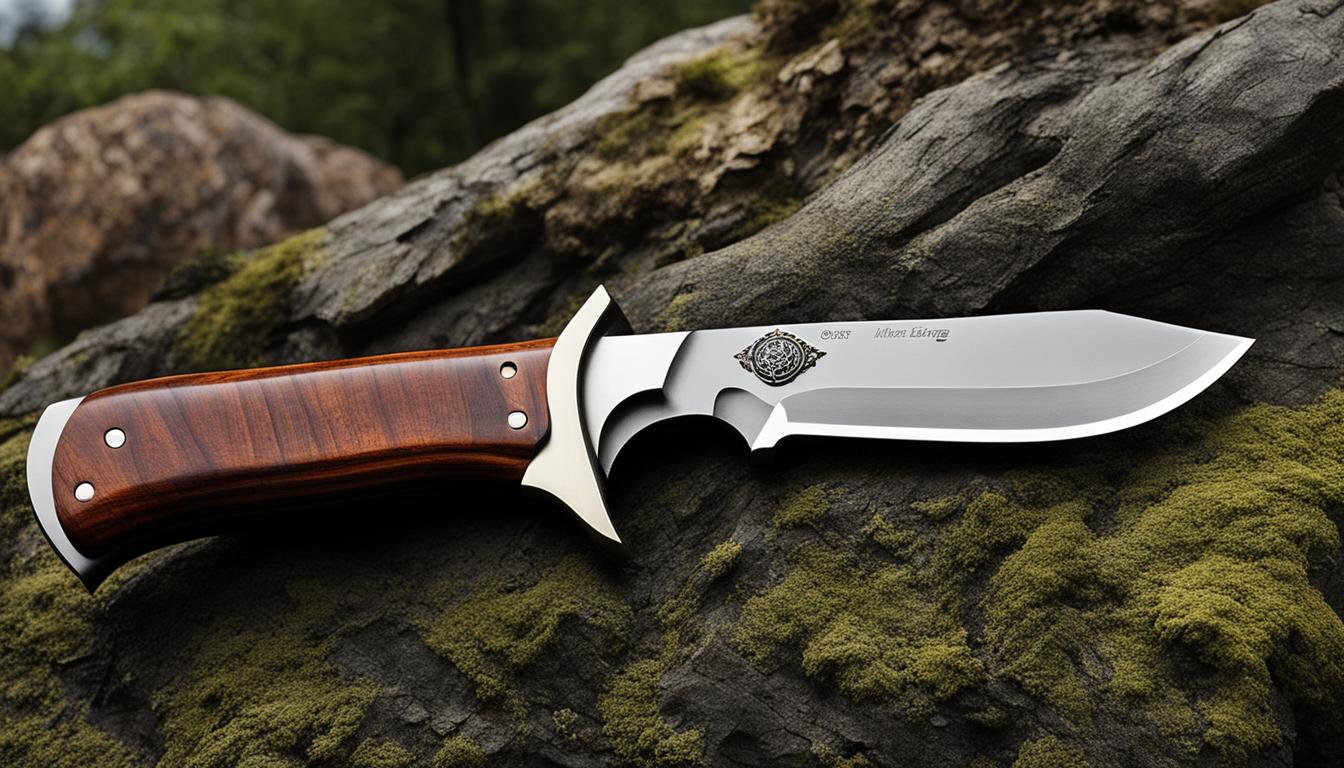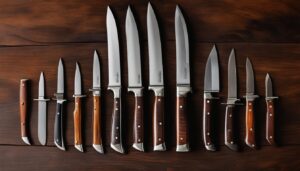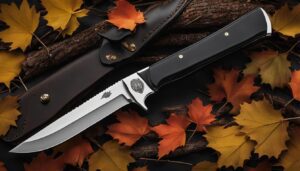As an outdoor enthusiast, I know the importance of having the right equipment for your adventures. One essential tool that every outdoor enthusiast should have is a high-quality hunting knife. Whether you’re camping, hiking, or on a hunting trip, a hunting knife serves multiple purposes, from skinning and cutting to self-defense. That’s why choosing the right hunting knife is crucial.
When it comes to hunting knives, full tang knives are considered the best choice for their durability and reliability. At Nooraki, a trusted supplier of handmade knives in Australia, you’ll find a wide selection of full tang hunting knives that are perfect for all your outdoor adventures.
But how do you choose the right hunting knife? There are several factors to consider, such as the shape and type of the blade, the steel material used, the handle design, the tang type, and the sheath quality. In this ultimate guide, I’ll walk you through all these considerations to help you make an informed decision.
Key Takeaways
- Choosing the right hunting knife is essential for a successful outdoor adventure.
- Full tang knives offer superior durability and reliability.
- Consider factors such as blade shape, steel material, handle design, tang type, and sheath quality when choosing a hunting knife.
- Nooraki offers a wide selection of high-quality full tang hunting knives in Australia.
- Always prioritize safety and responsible knife use during your outdoor activities.
The Shape and Type of the Blade
When it comes to hunting knives, the shape and type of the blade play a crucial role in determining their performance and versatility. Understanding the different blade shapes and their uses can help you make an informed decision when choosing a hunting knife that suits your needs.
Drop Point Blade
The drop point blade is one of the most popular blade shapes for hunting knives. It features a convex curve on the spine of the blade that slopes downward to the tip. This design provides excellent control and allows for precise cuts, making it ideal for skinning and general outdoor tasks.
Clip Point Blade
The clip point blade is characterized by a concave curve on the spine, which creates a sharp, fine point. This blade shape excels in precision work and piercing tasks, making it suitable for detailed cutting and stabbing motions. However, it may be less robust for heavy-duty tasks compared to the drop point blade.
Selecting the right blade shape depends on the type of hunting you will be doing. If you anticipate a variety of tasks, the drop point blade offers versatility and reliability. On the other hand, if you require a knife for more specialized tasks that demand precision, the clip point blade may be the better choice.
| Blade Shape | Advantages | Disadvantages |
|---|---|---|
| Drop Point | Versatile, precise cuts, suitable for skinning | May not excel in heavy-duty tasks |
| Clip Point | Precision work, fine point for detailed cutting | Less robust for heavy-duty tasks |
Understanding the strengths and weaknesses of each blade shape will enable you to choose the right hunting knife that meets your specific requirements. Whether you prioritize versatility or precision, selecting a blade shape that aligns with your intended use will enhance your outdoor experiences.
The Type of Steel
When choosing a hunting knife, one of the most important considerations is the type of steel used for the blade. The steel material significantly impacts the knife’s durability, sharpness, and maintenance. Two common options for hunting knife blades are stainless steel and carbon steel.
Stainless steel: Hunting knives made of stainless steel are known for their corrosion resistance. They can withstand exposure to moisture and harsh environments without rusting. However, stainless steel blades can be more challenging to sharpen than their carbon steel counterparts.
Carbon steel: On the other hand, hunting knives with carbon steel blades are easier to sharpen and typically hold an edge better. They are known for their excellent cutting performance and durability. However, carbon steel blades require more care to prevent rusting and corrosion.
When deciding between stainless steel and carbon steel, it’s essential to consider your specific needs and priorities. If you prioritize corrosion resistance and don’t mind putting in a bit more effort for sharpening, stainless steel might be the better choice. On the other hand, if you value sharpness and cutting performance, and are willing to provide extra care, carbon steel could be the ideal option for you.
Comparison of Stainless Steel and Carbon Steel:
| Stainless Steel | Carbon Steel | |
|---|---|---|
| Corrosion Resistance | High | Moderate |
| Sharpening Difficulty | More challenging | Easier |
| Edge Retention | Lower | Higher |
| Maintenance | Minimal | Requires more care |
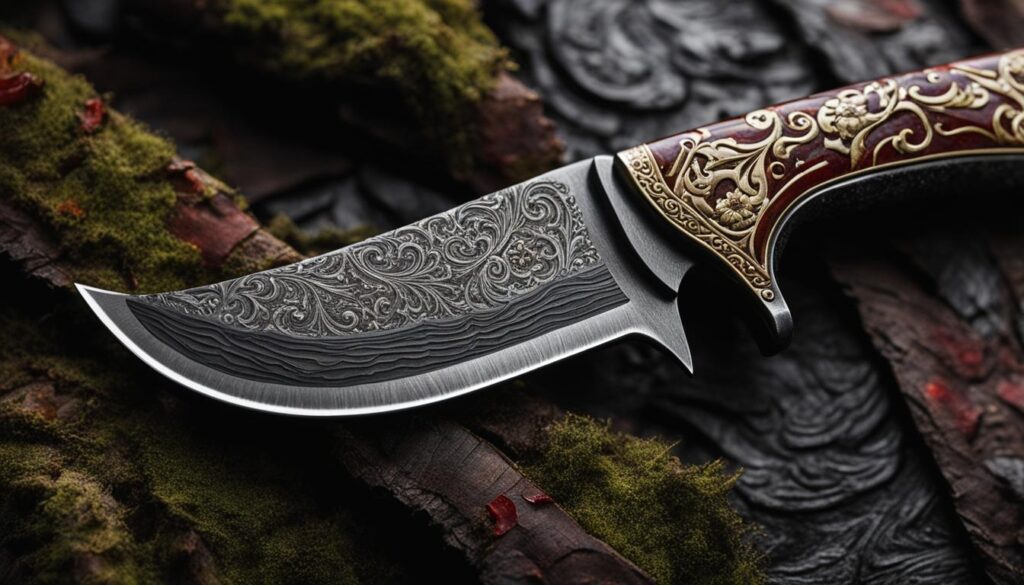
As you consider the type of steel for your hunting knife, keep in mind that both stainless steel and carbon steel have their advantages and trade-offs. The decision ultimately depends on your personal preferences, hunting style, and the environment in which you’ll be using the knife.
Hunting Knife Handles: Finding the Perfect Grip for Your Outdoor Adventures
When it comes to choosing a hunting knife, one of the most important considerations is the handle. The handle plays a crucial role in providing a secure and comfortable grip, ensuring that you have full control over your knife during your outdoor adventures. In this section, we will explore the different handle materials, ergonomic designs, and features that prevent slipping, allowing you to make an informed decision when selecting your hunting knife.
Handle Materials
The choice of handle material can greatly impact the overall performance and durability of your hunting knife. There are various options available, each with its own advantages and considerations. Common handle materials include:
- Wood: Provides a classic and natural look, but may require more maintenance to prevent water damage or warping.
- Rubber: Offers a secure and non-slip grip, even in wet conditions. It also absorbs shock and provides excellent insulation against cold temperatures.
- Plastic: Lightweight and resistant to moisture, plastic handles are low-maintenance options that offer good grip and durability.
- Artificial Composites: These handle materials combine the benefits of different materials, providing a balance of strength, durability, and grip.
Consider the specific demands of your hunting environment and personal preferences when choosing the handle material that suits you best.
Ergonomic Designs and Anti-Slip Features
An ergonomic handle design is essential for reducing hand fatigue and ensuring a comfortable grip during extended periods of use. Look for hunting knives with contoured handles that fit naturally in your hand, allowing for a secure and balanced grip. Some handles may have finger grooves or textured patterns to improve grip and prevent slipping, especially when wet or covered in blood.
“A good hunting knife handle should feel like an extension of your hand, giving you confidence and control in any situation.” – Outdoor Enthusiast
When selecting a hunting knife, consider how the handle feels in your hand and whether it provides the necessary grip and stability for your specific needs. Remember, the handle is where you’ll be exerting the most force and control, so it’s crucial to choose one that suits your individual preferences and hunting style.
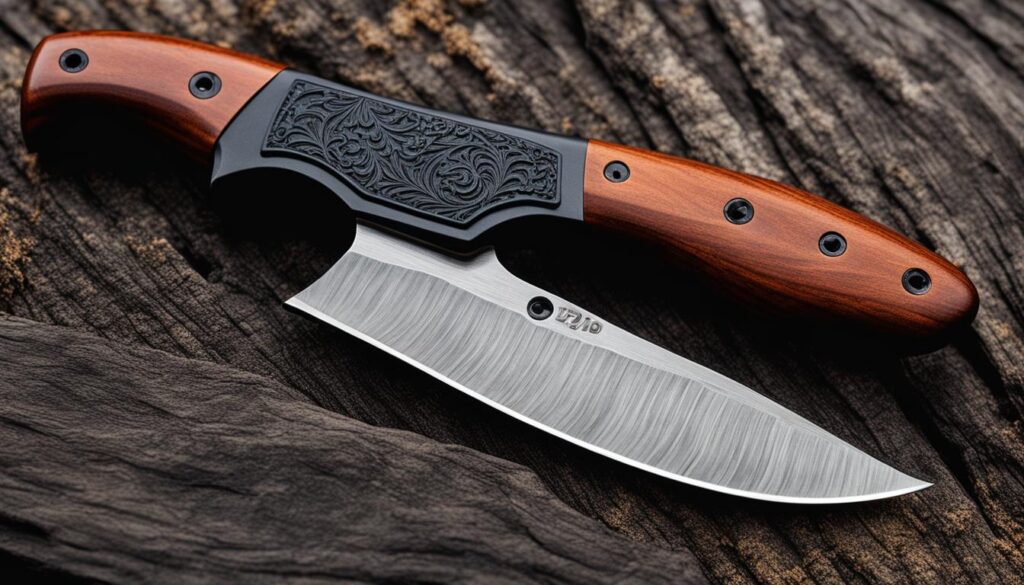

| Handle Material | Pros | Cons |
|---|---|---|
| Wood | Classic look, natural feel | Requires maintenance, may warp or absorb moisture |
| Rubber | Secure grip, shock absorption, insulation | May wear out over time |
| Plastic | Lightweight, moisture-resistant | Not as visually appealing, may lack durability |
| Artificial Composites | Strength, durability, grip | May be more expensive |
The Tang
When it comes to hunting knives, the tang is a crucial factor to consider. The tang refers to the part of the blade that extends into the handle. It plays a significant role in the overall strength and durability of the knife. There are two main types of tangs: full tang and partial tang.
Full tang knives have a blade that extends all the way through the handle, providing maximum strength and stability. The full tang design makes these knives incredibly durable and reliable, making them a popular choice among hunters. With a full tang, the blade and handle are essentially one solid piece of metal, minimizing the risk of breakage or failure during heavy use or challenging tasks.
In contrast, partial tang or hidden tang knives have a blade that only reaches halfway into the handle. While these knives can still be functional, they may not offer the same level of durability and strength as full tang knives. Partial tang knives are often lighter and more nimble, which can be advantageous in certain situations where weight and agility are priorities.
Overall, if you’re looking for a hunting knife that can withstand demanding tasks and provide long-lasting performance, a full tang knife is the way to go. It offers the utmost reliability and durability, giving you peace of mind during your outdoor adventures. Consider investing in a high-quality full tang hunting knife to ensure you’re well-equipped for any situation you may encounter.
The Sheath
When it comes to choosing a hunting knife, the quality of the sheath is just as important as the blade itself. A solid sheath plays a vital role in safely transporting and storing your knife during your outdoor adventures. It not only protects the blade from damage but also ensures that you can access your knife quickly and efficiently when needed.
When selecting a sheath, opt for one made of sturdy materials that can withstand the rigors of the outdoors. Leather, nylon, and Kydex are popular choices due to their durability and resistance to wear and tear. These materials offer excellent protection against moisture, rust, and other elements that could potentially harm your knife.
Additionally, pay attention to the retention system of the sheath. It should securely hold the knife in place to prevent accidental slips or falls. Some sheaths feature snap buttons, straps, or friction-fit designs to ensure a tight grip on the knife. Consider your personal preference and the type of activities you will be engaged in when choosing the right retention system for your hunting knife.
Comparative Table: Sheath Materials and Retention Systems
| Sheath Material | Advantages | Disadvantages |
|---|---|---|
| Leather | Durable, classic appearance, molds to the knife over time | May require regular maintenance and conditioning |
| Nylon | Lightweight, water-resistant, easy to clean | Not as durable as leather, may wear out over time |
| Kydex | Rugged, lightweight, excellent retention, moisture-resistant | Lacks the aesthetic appeal of leather |
“A high-quality sheath is crucial for ensuring the safe transportation and storage of your hunting knife. It not only protects the blade but also ensures quick and easy access when needed.” – Anonymous
Consider the specific needs of your hunting style and environment when selecting a sheath. If you often venture into wet or humid conditions, opt for a sheath that offers superior moisture resistance. If you prefer a classic and timeless look, a leather sheath may be the perfect choice. Remember, the sheath is an integral part of your hunting knife setup, and investing in a high-quality one will enhance your overall experience in the great outdoors.
Conclusion
Choosing the right hunting knife is crucial for outdoor enthusiasts to ensure durability and quality during their adventures. Consider factors such as blade shape, steel material, handle design, tang type, and sheath quality. Nooraki, a trusted supplier of handmade knives in Australia, offers a wide selection of high-quality hunting knives that meet the needs of both beginners and experienced hunters.
When it comes to durability, full tang hunting knives are the preferred choice. The blade extends all the way through the handle, providing unmatched strength and reliability. Full tang knives can withstand the rigors of hunting tasks, ensuring they won’t fail you in critical moments. Nooraki offers a range of full tang hunting knives that are built to last, making them a reliable companion for any outdoor adventure.
Quality is another important aspect to consider when choosing a hunting knife. Nooraki’s handmade knives are crafted with precision and attention to detail. Each knife is forged using high-quality materials, ensuring excellent performance and longevity. Whether you’re skinning game or performing intricate tasks, Nooraki’s hunting knives deliver exceptional quality and reliability.
Investing in a hunting knife from Nooraki means investing in your outdoor experiences. With their durability, quality, and wide range of options, you can find the perfect hunting knife for your needs. Get ready for your next adventure with a hunting knife that you can rely on.
Additional Considerations
As I prepare for my outdoor adventures, there is an important aspect that I must not overlook – knife laws and state regulations. It is crucial to be aware of the legalities surrounding knife carry and possession in my state, as well as any states I plan on visiting during my trips. By staying informed and adhering to local regulations, I can ensure a hassle-free experience throughout my outdoor excursions.
Each state may have its own set of knife laws and regulations, so it is essential to do thorough research before packing my trusty hunting knife. Understanding the specific rules will help me avoid any unnecessary legal issues and keep me on the right side of the law. Compliance with these regulations is not only important for my safety but also for the responsible use of my knife.
I value safety above all else and want to ensure that my outdoor activities are conducted responsibly. By familiarizing myself with the knife laws in my state and any states I plan to visit, I can confidently engage in my outdoor adventures while respecting the regulations set forth by local authorities. It’s my responsibility as an outdoor enthusiast to prioritize safety and abide by the law.
FAQ
What factors should I consider when choosing a hunting knife?
When choosing a hunting knife, consider factors such as the blade shape and type, steel material, handle design, tang type, and sheath quality.
What are the different blade shapes and types of hunting knives?
The drop point blade offers versatility, while the clip point blade is best for precision work and piercing tasks. Determine the type of hunting you will be doing to select the design that suits your needs.
What are the different materials used for hunting knife blades?
Stainless steel blades are corrosion-resistant but require more effort to sharpen, while carbon steel blades are easier to sharpen and hold an edge better but need more care. Consider the trade-offs between these materials when choosing a hunting knife.
What should I look for in a hunting knife handle?
The handle of a hunting knife should provide a secure and comfortable grip, even in cold or wet conditions. Look for a handle design that is ergonomic and prevents slipping to ensure a safe and comfortable grip while hunting.
What is the difference between full tang and partial tang hunting knives?
Full tang knives have a blade that extends all the way through the handle, providing strength and durability. Partial tang or hidden tang knives have a blade that only reaches halfway into the handle. Full tang knives are generally preferred for hunting due to their durability and reliability.
What should I consider when selecting a sheath for my hunting knife?
A solid sheath is essential for safe transportation and storage of your hunting knife. Choose a sheath made of sturdy materials with a reliable retention system to keep the knife in place. Consider the specific needs of your hunting style and environment when selecting a sheath.
Where can I find high-quality hunting knives?
Nooraki, a trusted supplier of handmade knives in Australia, offers a wide selection of high-quality hunting knives. Visit their website or contact them directly for more information.
Are there any additional considerations when packing for outdoor adventures with a hunting knife?
Yes, it’s important to check the knife laws in your state and any state you will be visiting. Laws regarding knife carry and possession can vary, so it’s important to stay informed and comply with local regulations to ensure a hassle-free experience. Always prioritize safety and responsible knife use during your outdoor activities.
